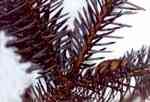 Foliage on a tree in the Seattle Arboretum [C.J. Earle].
| Picea omorika (Pančić) Purkyne 1877Common NamesOmorika [Serbian], Serbian spruce [English], el Serbskaya [Russian], Serbische fichte [German], èpicea de Serbie [French], picea di Serbia [Italian] (2).Taxonomic notesSyn: Pinus omorika Pančić 1876.DescriptionNarrow-pyramidal, straight tree to trunk 50 m tall. Bark thin, red-brown. First-order branches short (-2 m). Leaves 8-20 mm long, up to 2 mm wide; dark green on the upper side with 2 white stomatal lines on the lower side. Pollen cones light red, yound seed cones violet. Flowers from the end of April to June, depending on habitat. Cones pendant, 5-6 cm long, red-brown, ripening in October and November. Seed 2-3 mm long, with a wing 5-8 mm long. Cotyledons 5-6, 10-12 mm long (2).RangeW Serbia and E Bosnia in a small area around the river Drina, on the following mountains: Tara, Zvijezda, Viogor, Radomišlja, Jadovnik. This species was widespread in Europe millions of years ago (known by fossilized remains), but after Pleistocene glaciation it survived only in this refugium. It is found on chiefly calcareous soils at 400-1700 m elevation, usually on steep N-facing slopes. It occurs in pure stands or mixed with Picea abies, Abies alba, Pinus sylvestris, Pinus nigra, Fagus silvatica, Acer spp, Betula pendula, Populus tremula, Ostrya carpinifolia, Sorbus aucuparia, Salix caprea and other species. It sometimes grows in hydric soils with Alnus glutinosa, Picea abies, Abies alba, Fagus silvatica (2).Big TreeOldestDendrochronologyEthnobotanyIts wood is similar to that of the common European spruce Picea abies. It is widely planted as an ornamental tree in central and northern Europe and North America, and is sometimes used in forestry in these areas (2). It is exeptionally suitable to horticultural applications, being tolerant of poor soils, fast-growing to a height of about 50 feet, and tolerant of air pollution (3).ObservationsRemarksThe Latin name is also the Serbian name: Omorika. It was logged until the early 20th century, but the few remaining small stands are protected (2). The World Conservation Monitoring Centre - Trees database reports that it known from fewer than 1000 trees, occurring on 60 ha of forest in Pancic Narodni Nature Reserve in the Tara Mts. The only threat appears to come from competition with P. abies and Fagus orientalis (3).Citations(1) Silba 1986.(2) Branislav Jovanović. 1986."Picea omorika," in Flora Srbije. Belgrade: Serbian Academy of Sciences and Arts. (3) Hugh Johnson. 1993. The International Book of Trees. London: Mitchell Beazley. (4) Atlas Florae Europaeae 1998. See also Farjon 1990. Thanks to Milan Jovanovic for information and assistance contributed Feb-1999. |
[Picea] [Pinaceae] [home] This page is from the Gymnosperm Database |